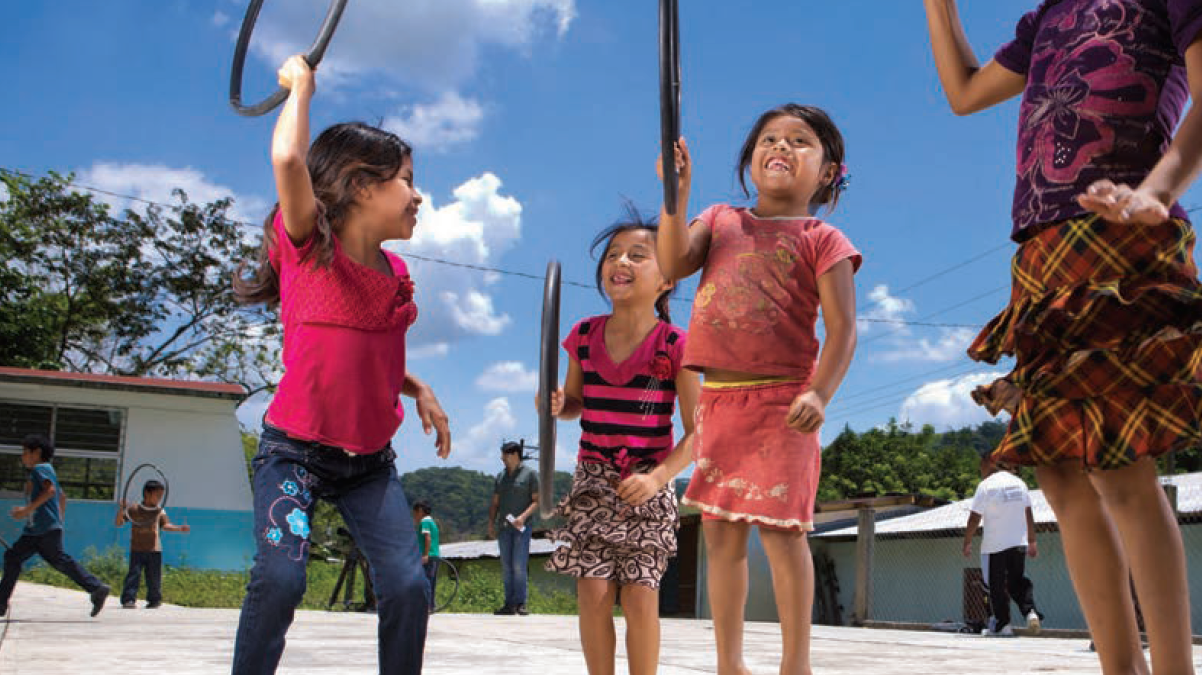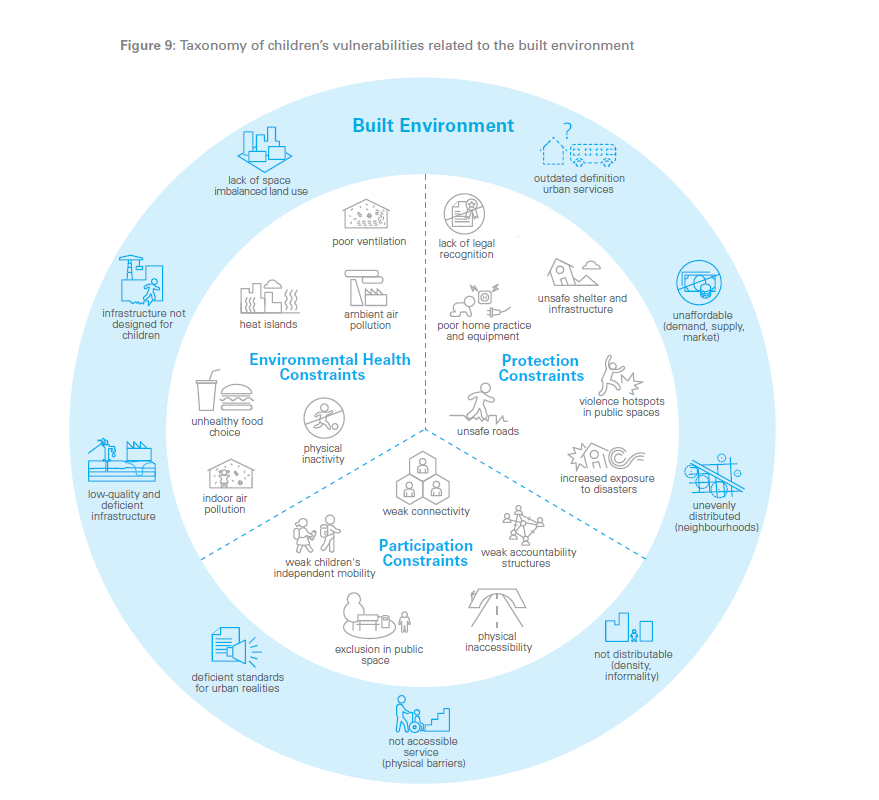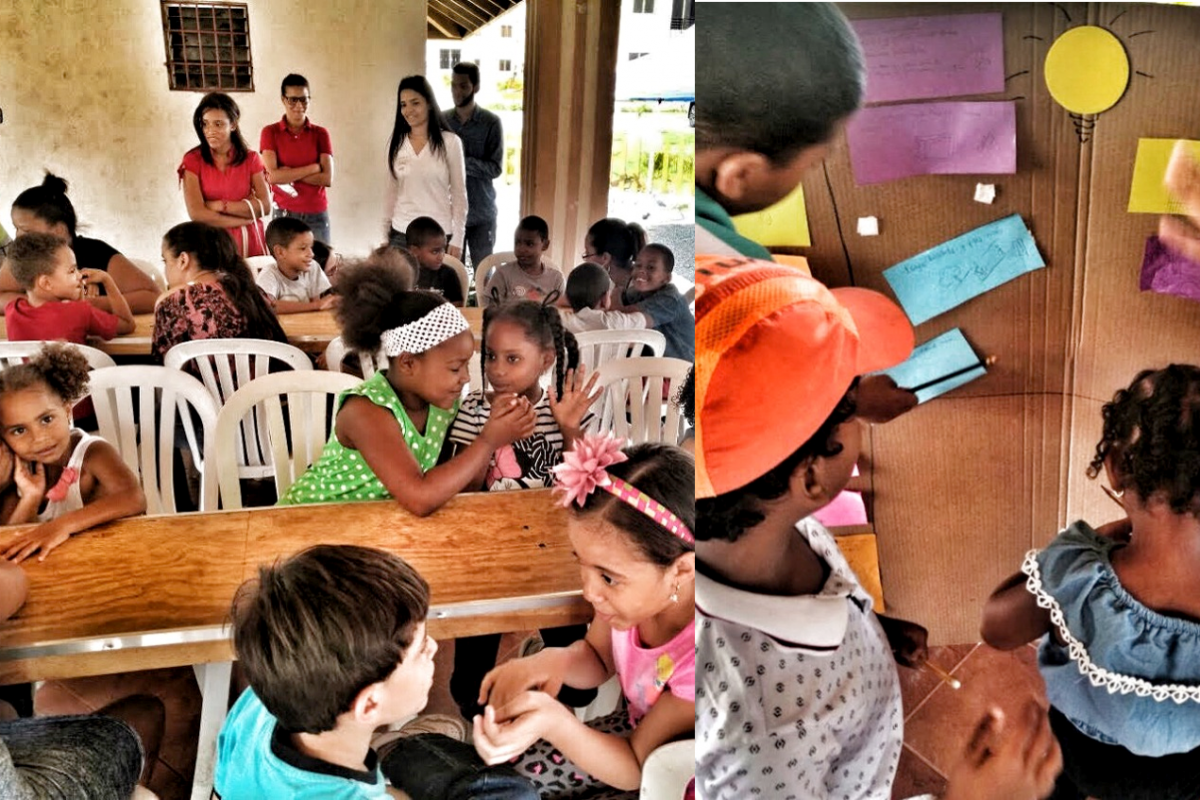
Keep up with our latest news and projects!

The Latin America and Caribbean (LAC) region is the most urban region on the planet. Children in the LAC region face unique challenges in their urban settings due to climate change disaster risks, unsustainable development patterns, large numbers of unplanned informal settlements, and violent crime concerns, among others. Polluted air causes respiratory diseases; unclean water and lacking sanitation causes diarrhoea; poorly managed water bodies cause vector diseases such as malaria; poorly designed streets, cities and buildings cause injuries—and these are just a few examples. In fact, according to the World Health Organization (WHO), altogether more than 80% of all major diseases and injuries are impacted by changeable factors in our environment.
In any community, the city at eye level perspective—or the experience that a pedestrian has moved throughout the space— is the most critical aspect of quality of life, health and wellness outcomes. Urban environments can be designed to facilitate social interaction, physical activity, civic engagement, improve mental health and promote child protection, safety and injury prevention, among other outcomes. Throughout the LAC, the building of social housing developments, connecting infrastructure and the subsequent building of new neighbourhoods often falls to private developers, construction companies and real estate investors. This case study of Condominium Pablo Mella in Santo Domingo, Dominican Republic included an extensive review of the highest quality peer-reviewed research around how to design, use and organise healthy communities to create effective and practical guidelines and policy recommendations that private developers, practitioners and policymakers can use to plan, design, and develop social housing projects that prioritise children, their rights, health and happiness throughout LAC. The LAC region has few context-specific tools to utilize when private companies develop large numbers of social housing projects, and the impact of these developments on children and their families are frequently inadequate and undermine their rights.
The 90 recommendations for children ages 0-3, pregnant women and their caregivers are divided into the following categories and include guidance, objectives and indicators on the following subjects, among others:
1. General Child Health – Provide basic healthcare services such as vaccinations, lactation coaches prenatal and primary care at an easily accessible location on-site.
2. Health Care Access – Provide HIV testing for pregnant women and access to antiretroviral treatment on-site.
3. Physical Activity – Provide public transit access within 800 meters of most residences, orient building entrances towards pedestrian traffic, provide safe outdoor playgrounds and exercise equipment, provide dedicated bicycle paths and safe pedestrian connections between residential buildings and amenities.
4. Nutrition – offer onsite weekly produce sales or community gardens for young children, caregivers and pregnant women, provide kitchen facilities in common spaces.
5. Mental Health – Provide walking trails, access to greenspace and alternatives to driving motor vehicles.
6. Social Interaction – Provide safe play spaces with ample seating, playgrounds and a human scale.
7. Environmental Health – Implement a tobacco-free policy throughout the community, offer clean potable water at an affordable rate to all community residents.
8. Child Protection, Safety and Injury Prevention – Provide ample and safe lighting throughout the community, offer car alternatives such as dedicated bicycle pathways and shared or subsidised bicycles, implement a weapon and violence-free policy for the neighbourhood.
9. Participation and Citizenship – Develop child participation mechanisms to solicit children’s opinions and input into developing the community. Examples might include electing a child mayor or using existing bodies or school councils to focus on children.
10. Education – Provide onsite subsidised child care and preschools, offer parent and caregiver coaching or set up a government mechanism that regularly solicits opinions and ideas about community life and potential improvements from children, their caregivers and pregnant women.
11. Legal Frameworks and Policies – Establish internal community frameworks and mechanisms that prioritise, promote and protect the rights or children. Examples include establishing a community children’s advocacy body to work with the private and public sector stakeholders on developing new programs in the community that prioritises children.
 Taxonomy of children’s vulnerabilities related to the built environment- UNICEF
Taxonomy of children’s vulnerabilities related to the built environment- UNICEF
These recommendations can be adapted for specific communities and regions based on a simple health risk assessment that evaluates the leading causes of death, disease and disability in children aged 0-3, caregivers and pregnant women, and tailors recommendations to address those concerns first. The recommendations include guidelines that can be applied at the building, street and community level. Ideally, case studies following this methodology would include components that address all three of these scales. In-situ data gathering was also incorporated here in order to take an integrated approach and involve the community stakeholders at every step, ensuring integration from the bottom-up and from the top-down in recommending pragmatic urban design and planning guidelines as well as policy recommendations that have been shown through evidence to support children and families. This knowledge can then be applied to the creation of a broadly applicable set of clear and concrete guidelines for any regional context. Together with thorough monitoring and evaluation, these tools can coalesce to form and articulate child-friendly social housing, neighbourhood and community frameworks with which to engage governments, developers, community stakeholders, and ultimately children, throughout the world.
 Children's urban planning workshop
Children's urban planning workshop
This article belongs to a series of stories about the city at eye level for kids! You can access the full book online in PDF or pre-order your hardcopy to be delivered to your home.
Get your book here– Prüss-Üstün, A., & Corvalán, C. (2006). PREVENTING DISEASE THROUGH HEALTHY ENVIRONMENTS: Towards an estimate of the environmental burden of disease(p. 106, Rep.). Geneva: World Health Organization. doi:92 4 159382 2